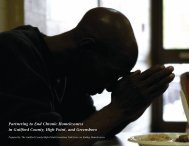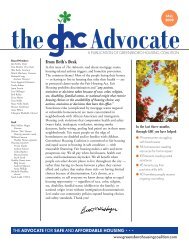data - Greensboro Housing Coalition
data - Greensboro Housing Coalition
data - Greensboro Housing Coalition
You also want an ePaper? Increase the reach of your titles
YUMPU automatically turns print PDFs into web optimized ePapers that Google loves.
Chapter 3<br />
Sheltered Homeless People in 2008<br />
This chapter provides a profile of the roughly 1.6 million people who used an emergency<br />
shelter or transitional housing program at some time from October 2007 through September<br />
2008. The chapter is based on HMIS <strong>data</strong> reported by 222 jurisdictions nationwide, weighted<br />
to represent the entire nation. The chapter focuses on:<br />
• The demographic characteristics of sheltered homeless people. Who were the<br />
sheltered homeless? How did the characteristics of homeless persons compare to those<br />
of the overall population living in poverty and the U.S. population as a whole?<br />
• The location of homeless service use. In what types of communities (urban, suburban<br />
or rural) did people use emergency and transitional housing programs? Where did they<br />
stay before using residential homeless services?<br />
• The patterns of homeless service use. How did people use emergency and transitional<br />
housing programs? How long did people stay in homeless residential facilities?<br />
Each of these topics is discussed for the total sheltered population and then separately for<br />
individuals and for persons in families. The HMIS-based estimates of sheltered homeless<br />
individuals include single adults, unaccompanied youth, persons in multi-adult households, and<br />
persons in multi-child households. A multi-adult household is a household composed of adults<br />
only—no children are present. A multi-child household is composed of children only (e.g.,<br />
parenting youth)—no adults are present. The HMIS-based estimates of homeless persons in<br />
families include persons in households with at least one adult and one child.<br />
3.1 Characteristics of People<br />
Using Homeless Shelters, 2008<br />
Characteristics of All Sheltered<br />
Persons, 2008<br />
Approximately 68 percent of the 1,594,000 Adult men (64 percent of adults)<br />
sheltered homeless people were homeless as Minority (62 percent of all persons)<br />
individuals and 32 percent were persons in Age 31 to 50 (40 percent of all<br />
families. As displayed in Exhibit 3-1, more<br />
persons)<br />
than two-thirds of sheltered individuals were<br />
Alone (67 percent of all persons)<br />
single adult men, and about one-quarter were<br />
Disabled (43 percent of all adults)<br />
single adult women. Very few people were<br />
homeless together with other adults but no<br />
children, and very few were unaccompanied or parenting youth. Among persons in families, 60<br />
percent were children under age 18, and 40 percent were adults.<br />
Chapter 3: Sheltered Homeless People in 2008 23




